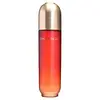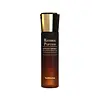What's inside
What's inside
 Key Ingredients
Key Ingredients

 Benefits
Benefits

 Concerns
Concerns

 Ingredients Side-by-side
Ingredients Side-by-side

Phellinus Linteus Extract
Skin ConditioningWater
Skin ConditioningButylene Glycol
HumectantDipropylene Glycol
HumectantPentylene Glycol
Skin ConditioningGlycerin
HumectantGlycereth-26
HumectantAlcohol Denat.
AntimicrobialNiacinamide
SmoothingChondrus Crispus Extract
Skin ConditioningSaccharum Officinarum Extract
MoisturisingTheobroma Cacao Seed Extract
AntioxidantPanax Ginseng Root Extract
EmollientVincetoxicum Atratum Extract
Skin ConditioningAlthaea Rosea Flower Extract
Skin ConditioningHelianthus Annuus Seed Oil
EmollientAngelica Gigas Extract
Skin ConditioningCornus Officinalis Fruit Extract
Skin ConditioningThymus Vulgaris Extract
PerfumingVelvet Extract
HumectantCandida Bombicola/Glucose/Methyl Rapeseedate Ferment
AntimicrobialSoluble Collagen
HumectantMacadamia Ternifolia Seed Oil
EmollientRaffinose
Skin ConditioningPEG-60 Hydrogenated Castor Oil
EmulsifyingAcrylates/C10-30 Alkyl Acrylate Crosspolymer
Emulsion StabilisingTromethamine
BufferingOctyldodeceth-16
EmulsifyingAdenosine
Skin ConditioningPolyquaternium-51
Skin Conditioning1,2-Hexanediol
Skin ConditioningDextrin
AbsorbentEthylhexylglycerin
Skin ConditioningPolyglyceryl-10 Pentastearate
Skin ConditioningSodium Stearoyl Glutamate
CleansingDisodium EDTA
Xanthan Gum
EmulsifyingCetearyl Alcohol
EmollientPhenoxyethanol
PreservativeParfum
MaskingBenzyl Salicylate
PerfumingAlpha-Isomethyl Ionone
PerfumingCitronellol
PerfumingGeraniol
PerfumingPhellinus Linteus Extract, Water, Butylene Glycol, Dipropylene Glycol, Pentylene Glycol, Glycerin, Glycereth-26, Alcohol Denat., Niacinamide, Chondrus Crispus Extract, Saccharum Officinarum Extract, Theobroma Cacao Seed Extract, Panax Ginseng Root Extract, Vincetoxicum Atratum Extract, Althaea Rosea Flower Extract, Helianthus Annuus Seed Oil, Angelica Gigas Extract, Cornus Officinalis Fruit Extract, Thymus Vulgaris Extract, Velvet Extract, Candida Bombicola/Glucose/Methyl Rapeseedate Ferment, Soluble Collagen, Macadamia Ternifolia Seed Oil, Raffinose, PEG-60 Hydrogenated Castor Oil, Acrylates/C10-30 Alkyl Acrylate Crosspolymer, Tromethamine, Octyldodeceth-16, Adenosine, Polyquaternium-51, 1,2-Hexanediol, Dextrin, Ethylhexylglycerin, Polyglyceryl-10 Pentastearate, Sodium Stearoyl Glutamate, Disodium EDTA, Xanthan Gum, Cetearyl Alcohol, Phenoxyethanol, Parfum, Benzyl Salicylate, Alpha-Isomethyl Ionone, Citronellol, Geraniol
Hippophae Rhamnoides Extract
MaskingPropanediol
SolventButylene Glycol
HumectantNiacinamide
SmoothingRosmarinus Officinalis Extract
AntimicrobialCamellia Japonica Flower Extract
EmollientCalendula Officinalis Extract
Skin ConditioningChamomilla Recutita Extract
Skin ConditioningGeranium Maculatum Extract
TonicLavandula Angustifolia Extract
Skin ConditioningThymus Vulgaris Extract
PerfumingOriganum Vulgare Flower/Leaf/Stem Extract
Skin ConditioningMilk Protein Extract
Saccharomyces/Rice Bran Ferment
HumectantAvena Sativa Kernel Extract
AbrasiveCamellia Sinensis Leaf Extract
AntimicrobialCitrus Limon Fruit Extract
MaskingBrassica Oleracea Italica Extract
AstringentBrassica Oleracea Acephala Leaf Extract
HumectantSolanum Lycopersicum Fruit Extract
AntioxidantDiospyros Kaki Leaf Extract
Skin ProtectingFragaria Vesca Fruit Extract
AstringentBrassica Oleracea Capitata Leaf Extract
Skin ConditioningAsparagus Officinalis Extract
Skin ConditioningCapsicum Annuum Fruit Extract
AntimicrobialSalicornia Herbacea Extract
Skin ConditioningPhragmites Communis Extract
Skin ConditioningDaucus Carota Sativa Root Extract
Skin ConditioningIlex Paraguariensis Leaf Extract
PerfumingBorago Officinalis Extract
EmollientCorchorus Olitorius Leaf Extract
Skin ConditioningFicus Carica Fruit Extract
HumectantPunica Granatum Fruit Extract
AntioxidantMorus Alba Fruit Extract
AntioxidantGinkgo Biloba Nut Extract
Skin ConditioningHydrolyzed Pea Protein
EmollientHydrolyzed Elastin
EmollientHelianthus Annuus Seed Oil
EmollientAscorbic Acid
AntioxidantCyanocobalamin
Skin ConditioningPyridoxine Hcl
Skin ConditioningTocopherol
AntioxidantRetinol
Skin ConditioningPanthenol
Skin ConditioningAtelocollagen
Skin ConditioningDesamido Collagen
Skin ConditioningHydrolyzed Collagen
EmollientSoluble Collagen
HumectantCollagen
MoisturisingCollagen Amino Acids
MoisturisingProcollagen
Skin ConditioningPalmitoyl Pentapeptide-4
Skin ConditioningAcetyl Hexapeptide-8
HumectantCaffeoyl Tripeptide-1
AntioxidantSh-Octapeptide-4
AntioxidantSh-Pentapeptide-19
Skin ConditioningNicotinoyl Tripeptide-1
AntioxidantSh-Decapeptide-9
Skin ConditioningCaffeoyl Sh-Octapeptide-4
AntioxidantHydrolyzed Glycosaminoglycans
HumectantSodium Hyaluronate
HumectantSodium Hyaluronate Crosspolymer
HumectantHydrolyzed Hyaluronic Acid
HumectantHydroxypropyltrimonium Hyaluronate
Hyaluronic Acid
HumectantSodium Acetylated Hyaluronate
HumectantGlutamic Acid
HumectantGlycine
BufferingSerine
MaskingAspartic Acid
MaskingLeucine
Skin ConditioningAlanine
MaskingLysine
Skin ConditioningTyrosine
MaskingPhenylalanine
MaskingValine
MaskingThreonine
Proline
Skin ConditioningIsoleucine
Skin ConditioningHistidine
HumectantMethionine
Skin ConditioningCysteine
AntioxidantPantolactone
HumectantMethyl Gluceth-20
HumectantDipropylene Glycol
HumectantGlycerin
HumectantBenzyl Glycol
SolventRaspberry Ketone
MaskingArginine
MaskingCarbomer
Emulsion StabilisingPolyglyceryl-10 Laurate
Skin ConditioningAdenosine
Skin ConditioningDipotassium Glycyrrhizate
HumectantPolysorbate 20
Emulsifying1,2-Hexanediol
Skin ConditioningCaprylyl Glycol
EmollientHydroxyacetophenone
AntioxidantDisodium EDTA
Ethylhexylglycerin
Skin ConditioningHippophae Rhamnoides Extract, Propanediol, Butylene Glycol, Niacinamide, Rosmarinus Officinalis Extract, Camellia Japonica Flower Extract, Calendula Officinalis Extract, Chamomilla Recutita Extract, Geranium Maculatum Extract, Lavandula Angustifolia Extract, Thymus Vulgaris Extract, Origanum Vulgare Flower/Leaf/Stem Extract, Milk Protein Extract, Saccharomyces/Rice Bran Ferment, Avena Sativa Kernel Extract, Camellia Sinensis Leaf Extract, Citrus Limon Fruit Extract, Brassica Oleracea Italica Extract, Brassica Oleracea Acephala Leaf Extract, Solanum Lycopersicum Fruit Extract, Diospyros Kaki Leaf Extract, Fragaria Vesca Fruit Extract, Brassica Oleracea Capitata Leaf Extract, Asparagus Officinalis Extract, Capsicum Annuum Fruit Extract, Salicornia Herbacea Extract, Phragmites Communis Extract, Daucus Carota Sativa Root Extract, Ilex Paraguariensis Leaf Extract, Borago Officinalis Extract, Corchorus Olitorius Leaf Extract, Ficus Carica Fruit Extract, Punica Granatum Fruit Extract, Morus Alba Fruit Extract, Ginkgo Biloba Nut Extract, Hydrolyzed Pea Protein, Hydrolyzed Elastin, Helianthus Annuus Seed Oil, Ascorbic Acid, Cyanocobalamin, Pyridoxine Hcl, Tocopherol, Retinol, Panthenol, Atelocollagen, Desamido Collagen, Hydrolyzed Collagen, Soluble Collagen, Collagen, Collagen Amino Acids, Procollagen, Palmitoyl Pentapeptide-4, Acetyl Hexapeptide-8, Caffeoyl Tripeptide-1, Sh-Octapeptide-4, Sh-Pentapeptide-19, Nicotinoyl Tripeptide-1, Sh-Decapeptide-9, Caffeoyl Sh-Octapeptide-4, Hydrolyzed Glycosaminoglycans, Sodium Hyaluronate, Sodium Hyaluronate Crosspolymer, Hydrolyzed Hyaluronic Acid, Hydroxypropyltrimonium Hyaluronate, Hyaluronic Acid, Sodium Acetylated Hyaluronate, Glutamic Acid, Glycine, Serine, Aspartic Acid, Leucine, Alanine, Lysine, Tyrosine, Phenylalanine, Valine, Threonine, Proline, Isoleucine, Histidine, Methionine, Cysteine, Pantolactone, Methyl Gluceth-20, Dipropylene Glycol, Glycerin, Benzyl Glycol, Raspberry Ketone, Arginine, Carbomer, Polyglyceryl-10 Laurate, Adenosine, Dipotassium Glycyrrhizate, Polysorbate 20, 1,2-Hexanediol, Caprylyl Glycol, Hydroxyacetophenone, Disodium EDTA, Ethylhexylglycerin
Ingredients Explained
These ingredients are found in both products.
Ingredients higher up in an ingredient list are typically present in a larger amount.
1,2-Hexanediol is a synthetic liquid and another multi-functional powerhouse.
It is a:
- Humectant, drawing moisture into the skin
- Emollient, helping to soften skin
- Solvent, dispersing and stabilizing formulas
- Preservative booster, enhancing the antimicrobial activity of other preservatives
Adenosine is in every living organism. It is one of four components in nucleic acids that helps store our DNA.
Adenosine has many benefits when used. These benefits include hydrating the skin, smoothing skin, and reducing wrinkles. Once applied, adenosine increases collagen production. It also helps with improving firmness and tissue repair.
Studies have found adenosine may also help with wound healing.
In skincare products, Adenosine is usually derived from yeast.
Learn more about AdenosineButylene Glycol (or BG) is used within cosmetic products for a few different reasons:
Overall, Butylene Glycol is a safe and well-rounded ingredient that works well with other ingredients.
Though this ingredient works well with most skin types, some people with sensitive skin may experience a reaction such as allergic rashes, closed comedones, or itchiness.
Learn more about Butylene GlycolDipropylene Glycol is a synthetically created humectant, stabilizer, and solvent.
This ingredient helps:
Dipropylene glycol is technically an alcohol, but it belongs to the glycol family (often considered part of the ‘good’ alcohols). This means it is hydrating and gentle on skin unlike drying solvent alcohols like denatured alcohol.
As a masking agent, Dipropylene Glycol can be used to cover the smell of other ingredients. However, it does not have a scent.
Studies show Dipropylene Glycol is considered safe to use in skincare.
Learn more about Dipropylene GlycolDisodium EDTA plays a role in making products more stable by aiding other preservatives.
It is a chelating agent, meaning it neutralizes metal ions that may be found in a product.
Disodium EDTA is a salt of edetic acid and is found to be safe in cosmetic ingredients.
Learn more about Disodium EDTAEthylhexylglycerin (we can't pronounce this either) is commonly used as a preservative and skin softener. It is derived from glyceryl.
You might see Ethylhexylglycerin often paired with other preservatives such as phenoxyethanol. Ethylhexylglycerin has been found to increase the effectiveness of these other preservatives.
Glycerin is already naturally found in your skin. It helps moisturize and protect your skin.
A study from 2016 found glycerin to be more effective as a humectant than AHAs and hyaluronic acid.
As a humectant, it helps the skin stay hydrated by pulling moisture to your skin. The low molecular weight of glycerin allows it to pull moisture into the deeper layers of your skin.
Hydrated skin improves your skin barrier; Your skin barrier helps protect against irritants and bacteria.
Glycerin has also been found to have antimicrobial and antiviral properties. Due to these properties, glycerin is often used in wound and burn treatments.
In cosmetics, glycerin is usually derived from plants such as soybean or palm. However, it can also be sourced from animals, such as tallow or animal fat.
This ingredient is organic, colorless, odorless, and non-toxic.
Glycerin is the name for this ingredient in American English. British English uses Glycerol/Glycerine.
Learn more about GlycerinHelianthus Annuus Seed Oil is the oil derived from the seeds of a Sunflower. Sunflower seed oil is non-fragrant. It is an emollient, meaning it helps to soften the skin.
Sunflower seed oil contains many fatty acids. The fatty acids found in sunflower seeds include (from highest amount to least): linoleic acid, myristic acid, palmitic acid, stearic acid, arachidic acid, oleic acid, and linolenic acid.
These fatty acids help the skin create ceramides. Ceramides play a role in repairing the skin barrier.
Helianthus Annuus Seed Oil helps moisturize the skin. This in turn helps the skin look more rejuvenated and smoother.
Sunflowers are rich in vitamin E.
Historians believe Indigenous cultures of North America domesticated sunflowers before corn. Thus they relied on sunflower oil for a variety of uses. One such use is moisturizing skin and hair.
Sunflower seed oil may not be fungal acne safe. We recommend speaking with a professional if you have any concerns.
Learn more about Helianthus Annuus Seed OilNiacinamide is a multitasking form of vitamin B3 that strengthens the skin barrier, reduces pores and dark spots, regulates oil, and improves signs of aging.
And the best part? It's gentle and well-tolerated by most skin types, including sensitive and reactive skin.
You might have heard of "niacin flush", or the reddening of skin that causes itchiness. Niacinamide has not been found to cause this.
In very rare cases, some individuals may not be able to tolerate niacinamide at all or experience an allergic reaction to it.
If you are experiencing flaking, irritation, and dryness with this ingredient, be sure to double check all your products as this ingredient can be found in all categories of skincare.
When incorporating niacinamide into your routine, look out for concentration amounts. Typically, 5% niacinamide provides benefits such as fading dark spots. However, if you have sensitive skin, it is better to begin with a smaller concentration.
When you apply niacinamide to your skin, your body converts it into nicotinamide adenine dinucleotide (NAD). NAD is an essential coenzyme that is already found in your cells as "fuel" and powers countless biological processes.
In your skin, NAD helps repair cell damage, produce new healthy cells, support collagen production, strengthen the skin barrier, and fight environmental stressors (like UV and pollution).
Our natural NAD levels start to decline with age, leading to slower skin repair, visible aging, and a weaker skin barrier. By providing your skin niacinamide, you're recharging your skin's NAD levels. This leads to stronger, healthier, and younger looking skin.
Another name for vitamin B3 is nicotinamide. This vitamin is water-soluble and our bodies don't store it. We obtain Vitamin B3 from either food or skincare. Meat, fish, wheat, yeast, and leafy greens contain vitamin B3.
The type of niacinamide used in skincare is synthetically created.
Learn more about NiacinamideSoluble collagen comes from animals and fish. It has a large molecule size, meaning it doesn't get absorbed into skin.
Instead, it sits on top of skin as a humectant to improve skin hydration. It has incredible water-binding properties and creates a water barrier on skin that prevents evaporation.
This ingredient is incredibly gentle and often used to counter more irritating ingredients.
While our skin does have collagen, this ingredient is not used by the skin for anti-aging. Applying collagen topically has not been linked to helping with collagen loss in skin. All the benefits of soluble collagen are related to hydration.
Fun fact: The name "soluble collagen" refers to its ability to dissolve in water.
Learn more about Soluble CollagenThymus Vulgaris Extract is a fragrance.